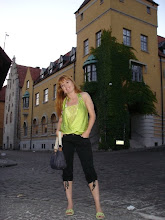
The reason for my trip was the Bavarian kick-off event of the European Satellite Navigation Competition 2009 (ESNC), an international innovation competition that awards the best ideas for innovative applications in the field of satellite navigation. It is organized by a company in Oberpfaffenhofen called Anwendungszentrum GmbH or “the Application Center for Satellite Navigation”. My company is sponsoring the competition with a special topic prize in the field of navigation and location based services for mobile phones.
The goal of the ESNC is to strengthen the international collaboration between a number of high-tech regions, particularly with regard to the development of applications and services made possible by the satellite navigation system Galileo. Galileo is a global navigation satellite system (GNSS) currently being built (still in trial phase) by EU and the European Space Agency (ESA). It is complementary to the U.S. Global Positioning System (GPS) and the Russian GLONASS but aimed at reducing Europe’s dependency on American and Russian satellite signals. The European Commission has expressed an ambition to have 30 satellites launched in 2013.
A number of international and regional events are scheduled for the ESNC this year and will provide information to developers and creative innovators on various satellite navigation initiatives in preparation for Galileo deployment, including how to use NAVTEQ digital map data, LBS content and services for application development. The ESNC is carried out under the patronage of the Bavarian State Ministry for Economic Affairs, Infrastructure, Transport, and Technology. There are over 36,000 people working in the Bavarian Aerospace industry alone, which is an indication of the size of the global market for these kinds of services and applications.
The event gave me a good opportunity to learn more about different development projects for use with satellite communication technology, including environmental mapping of seafloors, water depth and water quality. Other speakers covered geo-fencing solutions (tracking and secure locking / unlocking of valuable moving goods or hazardous materials), imaging and search applications using object recognition technology, and flexible address delivery of parcels by using GPS/GSM tracking solutions.
After the networking drinks I had dinner with the CEO of Anwendungszentrum and had interesting discussions over some delicious fish with melted hazelnut butter and spring vegetables, all the while it was snowing outside – big, pretty snowflakes like you want on Christmas Eve (well, at least if you’re a Swede). I was staying at Hotel Seehof by the Lake Wessling. The hotel was wonderfully peaceful with friendly staff, comfortable beds and it looked like a ski hotel in the middle of the Alps.
The goal of the ESNC is to strengthen the international collaboration between a number of high-tech regions, particularly with regard to the development of applications and services made possible by the satellite navigation system Galileo. Galileo is a global navigation satellite system (GNSS) currently being built (still in trial phase) by EU and the European Space Agency (ESA). It is complementary to the U.S. Global Positioning System (GPS) and the Russian GLONASS but aimed at reducing Europe’s dependency on American and Russian satellite signals. The European Commission has expressed an ambition to have 30 satellites launched in 2013.
A number of international and regional events are scheduled for the ESNC this year and will provide information to developers and creative innovators on various satellite navigation initiatives in preparation for Galileo deployment, including how to use NAVTEQ digital map data, LBS content and services for application development. The ESNC is carried out under the patronage of the Bavarian State Ministry for Economic Affairs, Infrastructure, Transport, and Technology. There are over 36,000 people working in the Bavarian Aerospace industry alone, which is an indication of the size of the global market for these kinds of services and applications.
The event gave me a good opportunity to learn more about different development projects for use with satellite communication technology, including environmental mapping of seafloors, water depth and water quality. Other speakers covered geo-fencing solutions (tracking and secure locking / unlocking of valuable moving goods or hazardous materials), imaging and search applications using object recognition technology, and flexible address delivery of parcels by using GPS/GSM tracking solutions.
After the networking drinks I had dinner with the CEO of Anwendungszentrum and had interesting discussions over some delicious fish with melted hazelnut butter and spring vegetables, all the while it was snowing outside – big, pretty snowflakes like you want on Christmas Eve (well, at least if you’re a Swede). I was staying at Hotel Seehof by the Lake Wessling. The hotel was wonderfully peaceful with friendly staff, comfortable beds and it looked like a ski hotel in the middle of the Alps.



No comments:
Post a Comment